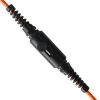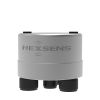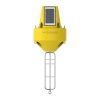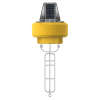NexSens T-Node FR Thermistor String
Features
- Build multi-point temperature strings by connecting T-Nodes to underwater cables
- +/- 0.075 C accuracy for precision temperature measurements
- Includes sensorBUS for connecting other smart sensors
- Free ground shipping
- Expedited repair and warranty service
- Lifetime technical support
- More
The NexSens T-Node FR Thermistor String provides high accuracy temperature data in a connectorized and addressable architecture for water quality profiling. Each node features an integral titanium thermistor secured and epoxied in a protective housing for underwater deployments. The nodes are connected in-series using marine-grade UW Cables with braided Kevlar core and double O-ring seals.
Each T-Node FR sensor is accurate to +/-0.075 C for high-precision measurements. The exposed titanium thermistor makes direct contact with water, allowing readings to stabilize within 60 seconds. Temperature data is transmitted on a RS-485 Modbus RTU string bus for integration with data loggers and SCADA systems. The string is powered by 4-28 VDC for operation on a 12 or 24 VDC power supply.
Mating UW Cables are available in lengths from 0.5m to 50m with a maximum 1,219 meters (4,000 feet) or 250 nodes. Strings terminate in a NexSens UW plug and receptacle connector, allowing additional sections or sensors to be added as required. Optional accessories include water quality sensors, pressure sensors, signal splitters, cable clamps, stainless steel mooring line, and communication adapters.
- Sensor: Thermistor
- Range: 0 to 45 C (32 to 113 F)
- Accuracy: +/-0.075 C
- Resolution: 0.01 C
- T90 Response Time: 60 seconds
- Refresh Rate: 2 seconds
- Maximum Sensors: 250
- Maximum Length: 1219m (4000 ft.)
- Maximum Depth: 200m (656 ft.)
- Communications: RS-485 Modbus RTU
- Power Requirement: 4-28 VDC
- Current Draw Per Node: 1.65mA active; 1.45mA idle; 0.04mA sleep
- Connection Seal: Double o-ring, gland and face seal
- Connector: 8 pin, sensorBUS
- Dimensions: 13.46cm L x 3.56cm Dia. (5.3" L x 1.4" Dia.)
In The News
Monitoring Lake Erie’s Eastern Basin: Building Long-Term Data and Real-Time Public Solutions
In the eastern basin of Lake Erie, off the coast of Dunkirk, New York, a data buoy collects valuable water quality, weather, and wave data that inform residents and regulatory groups of conditions on the water. Since 2011, Buffalo State University’s Great Lakes Center has maintained and operated the Dunkirk buoy with funding from the Great Lakes Observing System (GLOS) and field support from the NYSDEC Lake Erie Fisheries Research Unit. [caption id="attachment_38976" align="aligncenter" width="940"] The Dunkirk Buoy viewed from the research vessel after being deployed in early spring.
Read MoreCombining Academia and Lake Associations: Monitoring Lake Lillinonah
Lake Lillinonah may be Connecticut's second-largest lake, but it holds a great deal of meaning for locals and researchers in the surrounding towns. The lake is so significant to the surrounding community that it is one of many lakes in the United States with a dedicated lake association advocating for the resource. Jen Klug, Professor of Biology in the College of Arts and Sciences at Fairfield University , started her career at Fairfield as a natural progression in her background as a classical aquatic ecologist and found herself working closely with Lake Lillinonah's Friends of the Lake (FOTL) when they reached out to collaborate on an algae presentation for a public forum back in 2006.
Read MoreClimate Change Asymmetry Transforming Food Webs
Recent research from a University of Guelph (U of G) team reveals that warmer temperatures caused by climate change are forcing species to alter their behavior, causing food webs in Ontario lakes to transform. As temperatures warm, larger species hunt new prey in deeper waters, changing the ways nutrients and energy flow in lakes and triggering a “rewiring” of food webs. Dr. Timothy Bartley , study lead author and a post-doctoral researcher in the U of G's Department of Integrative Biology , spoke to EM about the work . “I got started on this when I first began graduate school and joined an ongoing project, which was a collaboration with the Ontario Ministry of Natural Resources and Forestry ,” explains Dr. Bartley.
Read More






































